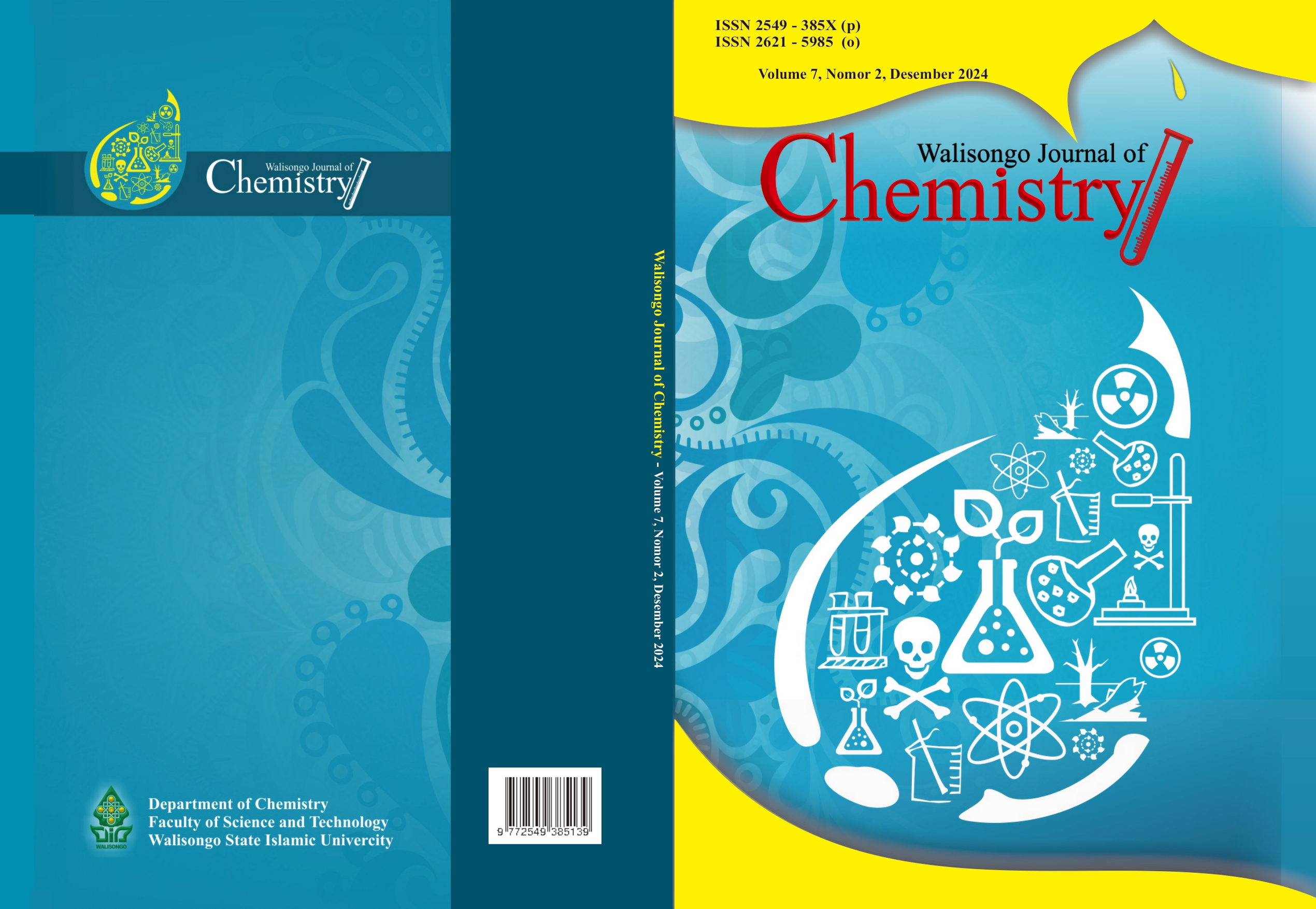Study of Synthesis of Ethyl-2-(4-Allyl-2-Methoxyphenoxy)Acetate in Polar Aprotic Solvents
DOI:
https://doi.org/10.21580/wjc.v7i2.23970Keywords:
eugenol, alkylation, aprotic solventsAbstract
Eugenol, a phenol-derived aromatic allylbenzene compound, exhibits a wide spectrum of biological activities (antifungal, antibacterial, antioxidant, analgesic, and antiseptic) and is an active ingredient in various hygiene products. It contains three reactive groups (hydroxy, allyl, and methoxy) and undergoes several reactions, including alkylation. The modification of the hydroxyl group of eugenol through alkylation has been performed using different alkylating agents. Alkylation has been carried out in various solvents (benzene, acetonitrile, methanol, and water) and at diverse temperatures. Hence, the investigation of this alkylation reaction on eugenol remains challenging. Correspondingly, the present study investigated the alkylation of eugenol by ethyl chloroacetate in polar aprotic solvents (N,N-dimethylformamide, dimethyl sulfoxide, acetonitrile, and tetrahydrofuran) at temperatures ranging from 0°C to room temperature. The product, ethyl 2-(4-allyl-2-methoxyphenoxy)acetate (3), was obtained in yields of 91%, 51%, and 47% using DMF, DMSO, and CH3CN, respectively. The product's structure was confirmed by NMR, IR spectroscopy, and HRESIMS analysis.
Downloads
References
Asnawati, D., Sudarma, I. M., Yuanita, E., Arlina, B. F., Hamdiani, S. & Kamali, S. R. (2015). Methylation of Eugenolusing Dimethyl Carbonate and Bentonite as Catalyst. Indonesian Journal of Chemistry, 15, 256- 262.
Bendre, R.S., Rajput, J. D., Bagul, S. D. & Karandikar, P. S. (2016). Outlooks on Medicinal Properties of Eugenol and its Synthetic Derivatives. Natural Products Chemical Research, 4, doi:10.4172/2329-6836.1000212
Fernandes, M. J. G., Pereira, R. B., Pereira, D. M., Fortes, A. G., Castanheira, E. M. S. & Gonçalves, M. S. T. (2020). NewEugenol Derivatives with Enhanced Insecticidal Activity. International Journal of Molecular Sciences, 21, 9257.
Firdaus, M., Kusumaningsih, T., Wibowo, A. H. & Hertiningtyas, C. (2020). Green Synthesis of Renewable Dimethyl Terephthalate-like Monomer from Eugenol. Sains Malaysiana, 49, 2715–2720. https://doi.org/10.17576/jsm-2020-4911-10
Frohlich, P. C., Santos, K. A., Palu, F., Cardozo-Filho, L., Silva, C. & Silva, E. A. (2019). Evaluation of The Effects of Temperature and Pressure on The Extraction of Eugenol from Clove (Syzygium aromaticum) Leaves Using Supercritical CO2. The Journal of Supercritical Fluids, 143, 313-320. doi: 10.1016/J.SUPFLU.2018.09.009
Khalil, A. A., Rahman, U. U., Khan, M. R., Sahar, A., Mehmood, T. & Khan, M. (2017). Essential Oil Eugenol: Sources, Extraction Techniques and Nutraceutical Perspectives. RSC Advances, 7, 3669-33681. doi:10.1039/c7ra04803c
Marchese, A., Barbieri, R., Coppo, E., Orhan, I. E., Daglia, M., Nabavi, S. F., Izadi, M., Abdollahi, M., Nabavi, S. M. & Ajami, M. (2017). Antimicrobial Activity of Eugenol and Essential Oils Containing Eugenol: A Mechanistic Viewpoint. Critical Review in Microbiology, 2017. doi: 10.1080/1040841X.2017.1295225
Mekky, A. E., Emam, A. E., Selim, M. N., Abdelmouty, E. S. & Khedr, M. (2023). Antibacterial and Antineoplastic MCF-7 and HePG-2 Characteristics of The Methanolic (80%) Clove (Syzygium aromaticum L.) Extract. Biomass Conversion and Biorefinery. https://doi.org/10.1007/s13399-023-03862-1
Mikhailovskii, A. G., Surikova, O. V., Limanskii, E. S. & Vakhrin, M. I. (2012). Synthesis of Isoquinoline Alkaloid Derivatives from Eugenol. Chemistry of Natural Compounds, 48, 285-287.
Mishra, S., Sachan, A. & Sachan, S. G. (2013). Production of Natural Value-added Compounds: An Insight into The Eugenol Biotransformation Pathway. Journal of The Indian Microbiology Biotechnology, 40, 545–550. doi:10.1007/s10295-013-155-9
Muliadi, Setiawan, T., Setiani, I. D., Limatahu, N. A. & Liestianty, D. (2023). Computational Chemistry: QSAR of Dental Disease-Causing Streptococcus mutans Using Eugenol Derivative Compounds from Clove Essential Oil. Techno, 12, 39–45. doi: https://doi.org/10.33387/tjp.v12i1.5793
Olea, A. F., Bravo, A., Martínez, R., Thomas, M., Sedan, C., Espinoza, L., Zambrano, E., Carvajal, D., Silva-Moreno, E. & Carrasco, H. (2019). Antifungal Activity of Eugenol Derivatives Against Botrytis cinerea. Molecules, 24. https://doi.org/10.3390/molecules24071239
Oliveira, A. S. D., Gazolla, P. A. R., Oliveira, A. F. C. D. S., Pereira, W. L., Maia, A. F. D. S., Santos, A. G., Silva, I. E. P. D., Mendes, T. A. D. O., Silva, A. M. D., Dias, R. S., Silva, C. C. D., Polêto, M. D., Teixeira, R. R. & Paula, S. O D. (2019). Discovery of Novel West Nile Virus Protease Inhibitor Based on Isobenzonafuranone and Triazolic Derivatives of Eugenol and Indan-1,3-Dione Scaffolds. PLoS ONE, 14, e0223017
Pinto, S. M. L., Rivera, Y., Sandoval, L. V. H., Lizarazo, J. C., Rincón, J. J. & Méndez, L. Y. V. (2019). Semisynthetic Eugenol Derivatives as Antifungal Agents Against Dermatophytes of The Genus Trichophyton. Journal of Medical Microbiology, 68, 1109–1117. doi:10.1099/jmm.0.001019
Solomons, T. W. G., Fryhle, C. B. & Snyder, S. A. (2014). Organic Chemistry 11th Edition. John Wiley dan Sons, Inc.
Suryanti, V., Wibowo, F. R., Kusumaningsih, T., Wibowo, A. H., Khumaidah, S. A. & Wijayanti, I. A. (2016). Amidation Reaction of Eugenyl Oxyacetate Ethyl Ester with 1, Diaminopropane. AIP Conference Proceedings, 1725, 020085. doi:10.1063/1.4945539
Suryanto, E. & Anwar, C. (2012). Sintesis Antioksidan 4,6-Dialil-2-Metoksifenol dari Alil Eugenol Melalui Penataan Ulang Claisen. Chemistry Progress, 1, 1–8.
Ulanowska, M. & Olas, B. (2021). Biological Properties and Prospects for The Application of Eugenol-a review. International Journal of Molecular Sciences, 22, 3671. https://doi.org/10.3390/ijms22073671
Wael, S., Mahulette, F., Watuguly, T. W. & Wahyudi, D. (2018). Effect of Leaf Syzygium aromaticum on Lymphocytes and Macrophages Mice Balb/c. Traditional Medicine Journal, 23, 79–83.
Yulianti, R., Onggo, H. & Syampurwadi, A. (2012). Effect of Dielectric Constant And Dispersion of Particle on Hydrophobicity of Carbon Nanotube Based Electrocatalyst Film. Indonesian Journal of Materials Science, 14, 224-28.
Downloads
Published
How to Cite
Issue
Section
License
Copyright (c) 2024 Walisongo Journal of Chemistry

This work is licensed under a Creative Commons Attribution-NonCommercial-ShareAlike 4.0 International License.
The copyright of the received article shall be assigned to the publisher of the journal. The intended copyright includes the right to publish the article in various forms (including reprints). The journal maintains the publishing rights to published articles.
In line with the license, authors and any users (readers and other researchers) are allowed to share and adapt the material. In addition, the material must be given appropriate credit, provided with a link to the license, and indicated if changes were made. If authors remix, transform or build upon the material, authors must distribute their contributions under the same license as the original.









